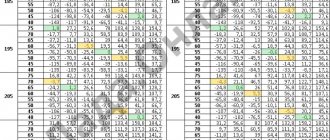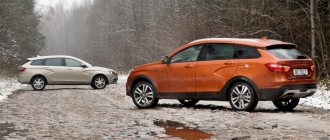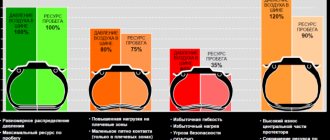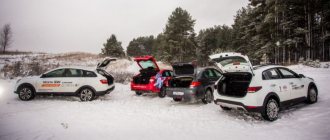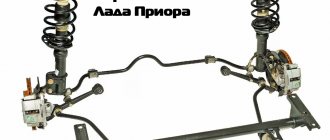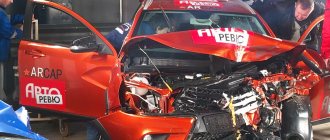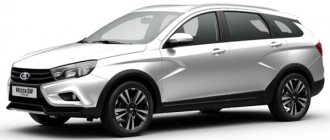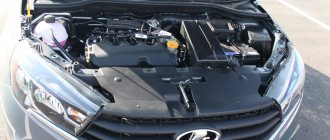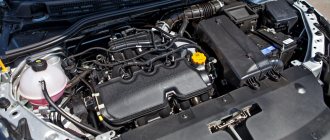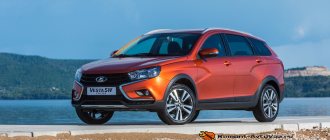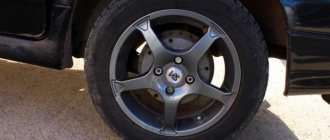Important points
The choice is not an easy matter, there are many manufacturers to suit every taste and budget, studded, Velcro. Different sizes of tires and wheels. Let's try to understand a complex topic using a specific example. I’ll show you which tires I chose, the tire size – width, height, wheel size. I’ll tell you why I decided to choose these particular tires, what motivated me and how much it costs.
I do not advertise any products or collaborate with stores. I bought the wheels with my own money. All advice is personal, you may not agree with it. Please express your questions and opinions in the comments.
Tire markings and designations
Surely not all drivers know what numbers mean what on tires. For example, factory tires on the Lada Vesta are 185/65 R15.
Profile height in % of width. That is, in our case, 65% of 185 mm (about 120). Tire type is radial, designated by the letter “R”. There are also diagonal tires, but now they are more often used for special equipment.
Next, the diameter is indicated, not the radius, as many people mistakenly believe. It's the letter "R" that confuses them. The diameter is written in inches (25.4 mm).
Winter tires for Lada Vesta Cross
If you need winter tires for your Lada Vesta Cross, you should contact one of the many online stores where you can specify the wheel parameters you need and all you have to do is choose. The easiest way is to go to Yandex.Market, open the Auto category and select Tires. In the parameters, enter 205/50 R17 if you are using standard wheels, or any other value for your wheels.
In addition, you can select the “Discounts and promotions” category and save on your purchase. As a result, we get a lot of options from various manufacturers in the price range from 2,500 to 18,700 rubles per wheel. Among them there are both friction and studded types of rubber. Which one is preferable is up to you to decide, based on your available budget and personal preferences.
Remember that high-quality tires, if used correctly, will serve you for several seasons and will ensure a comfortable ride and safety on the road.
| Acceptable tire and wheel options | |
| Tires | Discs |
| 195/65 R15 | 6.0Jx15 ET37 |
| 205/55 R16 | 6.0Jx16ET40 |
| 205/50 R17 | 6.5Jx17 ET41 |
| 205/45 R18 | 7.0Jx18 ET38 |
| 215/45 R17 | 7.0Jx17 ET38 |
| 215/40 R18 | 7.0Jx18 ET38 |
Disk options
The diameter must match that indicated on the tire. The disc must also be the correct width.
Rim width is measured in inches (in our case 6 inches). This disc can accommodate tires with a width of 175 to 205 mm.
But ideally 185-195 mm. The disc must also fit the car (Lada Vesta). The number of mounting holes on the disk and hub must match (4 pcs.). The diameter of the location of the mounting holes (100 mm) is also important.
The diameter of the central hole of the wheel must also match (for us 60.1 mm). If it is larger, then you can buy special inserts.
Disc offset
This important parameter, denoted by the Latin letters “ET”, is measured in mm. It means the distance between the axis of symmetry of the disk and the axis of attachment of the disk to the hub.
The smaller this distance, the more the disc moves outward, and the larger the car track.
For example, on a Lada Vesta on 15-16 wheels the offset is 50 mm and the track is 1510 mm.
If we take the “Cross” version, then it has 17 wheels with an offset of 43 mm. Compared to the regular version, the wheel is 7 mm larger. The track will already be 1524 mm - 7 mm will be added to each wheel.
It is not recommended to change this parameter by more than 5 mm; the car’s handling and the load on the suspension will change.
All acceptable wheel types are listed in the owner's manual. Therefore, it is better to follow AvtoVAZ’s recommendations.
This is 185/65 R15 or 195/55 R16. The first size is the most common. The second is not produced by all factories and is more expensive than 205/55 R16. Although a little smaller in size. It installs on standard 16-wheel drives without any problems and doesn’t hit anything on Vesta.
What other tire parameters are recommended for the Lada Vesta Cross?
In addition to the listed characteristics, this model represents a technological breakthrough in the long history of the Lada brand. These adjustments relative to the classic modifications could not but affect the characteristics of the wheels, which have the following distinctive features:
- The recommended wheels for Vesta SV Cross in size 17 are at odds with the understanding of budget tires for the Russian consumer. The wheel rim parameters for this modification are 6.5J x 17 ET43 - this is a very rare size to find a worthy replacement.
- Installing tires with a diameter of 16 inches with a complete replacement of wheels will cost almost the same as purchasing new tires with a mounting diameter of R17. At the same time, having assembled wheels in the garage will allow the car enthusiast to save money and time on tire fitting for 4-5 seasons in a row, which will fully cover the costs. If you already have carefully balanced wheels, the car enthusiast can do this procedure independently, having with him only a wheel wrench and a compressor with a pressure gauge for inflating the tires.
Alloy wheel KiK 6J x 16 ET41
- Experts, recommending the installation of rubber of a smaller size than factory products, explain the successful choice by the fact that the high profile (up to 60 mm) ensures traction of the rubber along the side cord, and not just along the sole. In this case, the cylinder contains an increased air buffer, which completely absorbs all shock and vibration loads on the wheel already in the suspension part of the vehicle. This technical solution helps to increase the service life of the vehicle, as well as its main systems - brakes, hubs, bearings, suspension and steering rods.
Considering that any gas compresses when the thermometer drops, it is better to keep the pressure indicators for such rubber at 2.4 atm. In this case, when driving, rolling resistance will practically not interfere with developing the required speed, which will lead to significant fuel savings.
The wheel size of the Lada Vesta SV Cross does not have to be kept exactly in accordance with the recommended parameters, paying attention only to the disc offset. These changes will allow us to completely maintain the point of load application to the hub in accordance with the design parameters. At the same time, this will increase the comfort and safety of the driver, as well as his passengers, and save the driver’s budget. After all, tires in smaller sizes are more accessible both in purchase and during installation work.
The start of sales of the Lada Vesta SV Cross all-terrain station wagon was given about a year ago. The new product of the domestic automobile industry turned out to be quite successful in sales. This is facilitated by a fresh design and good build quality. In addition to this station wagon, the AvtoVAZ line, as you've probably heard about, includes the Vesta sedan models (regular and cross versions) and the Vesta SV city station wagon. A characteristic difference between the SV Cross station wagon and other models is the installation of large wheels with a diameter of 17 inches. In this article, we suggest delving into the topic of wheels and answering basic questions about choosing tires for the Lada Vesta SV Cross.
Experienced car owners know that tires are an important component in the operation of the car. The choice of tires affects many parameters, including handling, braking distance, fuel consumption, vehicle acceleration dynamics and road stability. In addition, well-selected tires reduce driving noise and reduce the wear and tear of your vehicle's suspension. As you can see, the choice of car tires for the Lada Vesta SV Cross, as well as for any other car, must be approached very responsibly.
How to choose tires
I decided on some parameters in advance - I definitely decided that I would buy studded tires. I live in a small town where the roads are not always cleaned; sometimes I go out of town. If you live in a region where there is a real Russian winter, then there is no alternative to thorns.
Velcro performs much worse on ice than studded tires. Of course, it is quieter and more comfortable, but if you make a choice between comfort and safety, then the second is more important.
I decided exactly what brand of tires I would buy. The last car had Michelin X Ice North 2.
I've driven it 65 thousand km in 7 years and it still looks fine. Over time it has lost its properties, but most of the thorns have been preserved. The tires are comfortable and performed well on slippery roads and asphalt.
I also decided to put Michelin on the Lada Vesta; last year a new modification, X Ice North 4, was released.
I read a lot of reviews, feedback, comments. This is one of the best tires available today. You shouldn't skimp on tires. If you compare the braking distance at 100 km per hour on good tires and cheap ones, the difference is 30-40 meters.
Of course, tires cannot provide a guarantee, and you can fly off the track with any tires. But high-quality wheels will help you avoid an accident, and the chance of this is much higher.
Often people do not have enough money, they buy the tires they earned. Something else is not clear - cheap tires on alloy wheels. It is better to buy high-quality rubber, but stamped ones. Beauty and tuning are good, but safety is more important.
How to choose the right winter tires for Lada Vesta SW Cross
On a note!
Not every tire will have ideal grip properties on slippery surfaces in the winter. If the car enthusiast follows the recommendations below, then he will not have any problems when operating the vehicle:
- If the driver drives his Lada exclusively in the city, then the all-season M + S version with hard treads that will not wear out quickly during sharp braking or when turning on asphalt surfaces will suit him.
- When the vehicle is operated on country roads, or in the region where the driver lives, the air temperature often drops below -10 degrees Celsius, then it is simply impossible to do without full-fledged winter tires. And it’s even better if it is equipped with multi-directional metal spikes, which will ensure the stability of the car during acceleration, braking and cornering.
- If the car is planned to be used on rough terrain with completely snowy roads, then a studded tire will be unnecessary, because the studs play virtually no role in traction, and the main function is taken over by the soft tread. Thus, a car enthusiast should purchase a friction tire, the surface of which is cut into numerous lamellas with sharp edges.
Friction tires on Lada Vesta SW Cross
These elements, when pressed on them under the weight of the car, move apart, forming dozens of cracks, into each of which snow mass falls, lingering there for a certain time.
As the wheel rotates, the traction surface increases significantly, which provides additional frictional force that pushes the car forward without slipping.
If excess moisture forms under the wheels (for example, at zero temperature outside the window, when the snow turns into mush), then it is effectively removed through special grooves for collecting water between the blocks of lamellas.
- When choosing wheels, a car enthusiast can turn not only to companies that are authorized brands of the concern, but also to other brands whose products are adapted for normal use in the middle zone. This means that the chemical composition of the rubber must be selected in such a way that the protectors do not harden even at extremely low temperatures.
You may be interested in this About Dunlop summer tires
It is advisable to select tires that contain admixtures of silicate materials and create an abrasive surface during wear. The most popular brands for Russian car enthusiasts are Nokian, Bridgestone, Pirelli, Michelin, Amtel, Viatti and some other companies that are widespread in the Russian Federation.
Important!
Before choosing a particular tire brand, a car enthusiast needs to verify their authenticity by checking the technical specifications on the tire manufacturer’s website with the data at the retail outlet.
Studded tires for Lada Vesta SW Cross
How much money is needed
I had 30 thousand rubles, went shopping, compared prices.
Advice: do not buy tires and wheels at the first store you come across, prices vary greatly.
In neighboring stores, the price per set may differ by 6-8 thousand. For example, I found Michelin tires for the Lada Vesta in the cheapest store that cost 3,950 rubles. The most expensive one costs 4,900 rubles. “SKAD” wheels: cheap – 4000, expensive – 4500.
The kit could be bought for 32 thousand, and exactly the same one in another store for 38. This is provided that the diameter is R15. If we compare 16 wheels, I couldn’t find Michelin 195/55 R16 tires; other options start from 5,500 rubles. The closest size to the factory one is 195/60 R16, but the price tag for it is too high - from 6800 rubles.
A larger tire 205/55 R16 costs from 5,500 rubles - a difference of 1,300. The price for 16 SKAD wheels is 5,000 rubles, a set with tires costs about 42 thousand.
I found the wheels and tires in an online store, I won’t indicate the name so as not to advertise. It turned out cheaper there, the order is delivered within a week, tire fitting costs 600 rubles. For the money with alloy wheels it was only enough for 15 wheels. I wanted to buy 16 from stampings, but I didn’t. I also considered buying 16 wheels without rims to put them on the factory ones. Later I thought about saving up money for good CDs.
Advantages and disadvantages
For 15 disks, the advantages are:
- Price (the set is 9,000 rubles cheaper).
- The car drives smoother.
- The wheels are practical, easier to find in a store.
- It's harder to get a side cut.
- Less chance of denting discs.
With 16 wheels, the Lada Vesta looks more beautiful and handles better. As a result, I settled on size 15 - 195/65 R15. In this size, the outer diameter, compared to stock wheels, is 13 mm larger. The wheel arch is filled out more, but the wheel appears visually smaller. The ground clearance rises by 6.5 mm.
This option is also suitable for the Cross package. The difference in outer diameter with standard tires is only 2 mm.
I was worried that the front wheels would hit when turning. Therefore, I bought wheels with an offset of not 50, but 45 mm. This does not affect anything, and for the Cross the offset is generally 43 mm.
Features of choosing a tread
First of all, here you need to start from the operating features of the vehicle. Low-profile tires are also suitable for urban conditions. If you plan to drive on dirt roads or off-road, then you will have to take higher tires. In addition, the noise level of the tires should also be taken into account. To make the ride more comfortable, you should pay attention to soft tires.
Based on the type of pattern, there are four types of protectors:
- symmetrical directional. The best option if you plan to drive at high speeds. At the same time, the models are resistant to aquaplaning. This pattern is well suited for high-quality drainage of water upon contact. The main disadvantage is high noise;
- symmetrical non-directional. A universal option that maintains an optimal balance between efficiency and comfort. Perhaps the water drainage rates here are not the highest, but the tires are quite good for slow water. At the same time, it will be comfortable to drive both on gravel and on the highway;
- asymmetrical non-directional. The outer part is characterized by increased rigidity, while the inner element is designed for improved drainage. The center of the rubber is designed in such a way as to increase directional stability. The disadvantage comes down to poor absorption of vibration vibrations due to the rigid center and external element;
- asymmetrical directional. Such models are the most difficult to come across, since they are practically not produced now. The elements were produced in order to smoothly distribute the load over the entire surface of the tires, as well as ensure the highest quality drainage. At the same time, car owners had to carry two spare tires with them, which led to a decrease in demand for this option.
It will also be interesting to read: All-wheel drive crossovers with plug-in or permanent drive
It is worth noting that there is no ideal option here; each type of tire has its own advantages and disadvantages, so the choice must be made based on the driving style, as well as the operating conditions of the vehicle.
Does the speedometer differ in speed?
Many companies have conducted tests that compare speedometer readings with real speed. An error of 3-5 km at 100 km per hour is normal and exists on almost all cars. Usually the speedometer shows more than it should. The higher the speed, the greater the error, which can reach 20 km per hour.
On the regular Lada Vesta and the Cross version, the difference in the outer diameter of the wheel is about 15 mm. On cars with the same gearbox and equal engine speeds, the speed varies. Vesta Cross will go 2.5 km/h faster. But it’s unlikely that anyone adjusted and adjusted the speedometer on the Cross. If I'm wrong, write in the comments, maybe everything is wrong.
If you measured the actual speed of the car, be sure to write it down. Let's find out how different the speed of a regular Vesta is from the Cross configuration. Also indicate what wheels are installed on your car and their offset. If you set a certain size and difficulties arise (for example, the wheel began to touch), write to us. This will warn other drivers. Your experience may be useful, please share it.
What pressure should be in Lada Vesta tires
Ride comfort indicators depend 70% on the size of the wheels and the correct inflation. This car is equipped with three types of wheels, and for each version the recommended tire pressure for the Lada Vesta is different.
Recommended pressure At.
An important parameter is the actual load of the machine. The above values are relevant for 4 adults in the car. If there is an additional load of about 100 kg inside the trunk. 0.1-0.2 units should be added to the nominal values.
The company insists on timely monitoring of correct tire inflation. In the absence of proper care, a decrease in actual indicators by more than 15% from the standard, such negative effects may occur.
- Accelerated wear of the tread.
- Reduced steering sensitivity.
- Increased braking distance.
- Increased fuel consumption.
- The likelihood of hydroplaning on wet asphalt increases.
To facilitate control, a TPMS system is installed on board the machine, which automatically measures tire inflation in real time. Thus, it is almost impossible to “mess up” the release wheel.
Is the car out of warranty?
If you do not put something completely unusual on the car, then there will be no problems with the dealer. They sell and install wheels themselves, which do not always correspond to the dimensions of AvtoVAZ. If you were denied a warranty due to the size of the wheels, be sure to write and we will discuss the issue. So far I am not aware of such cases.
As a result, I ordered Michelin X Ice North 4 size 195/65 R15, they are a little more expensive than 185. I paid 4040 rubles for them. I bought the wheels from SCAD Samurai with an offset of 45 mm - 3590 rubles. Plus 600 rubles – tire fitting. Slightly exceeded my budget, spent a total of 31,120 rubles. The discs were packed in boxes, nothing was damaged.
The stove on the Lada Vesta does not warm the feet well - what to do
If you liked the publication, give it a thumbs up, subscribe to the channel, and write comments. What else would you like to know about Vesta? If you share this article on social networks, it will be very great for the development of the channel!
Another flight. How is the Cross suspension different besides shock absorbers?
With foreign cars it’s easy, with ours I think everything is somehow simpler (unification), though.
This is a fundamental question, let's figure it out together. We need to find out once and for all, since we are choosing this car, then the choice of wheels will become clearer.
It is well known that changing the offset (ET) is undesirable. Even a small change in the offset, in addition to changing the track width, leads to a change in such an important suspension parameter for vehicle handling as the roll-in shoulder
. A large change in offset leads to an increase in the load on the suspension elements and wheel bearing, and, in the limit, to the wheel touching the suspension elements and body. The acceptable deviation is +/-5mm. Perfectionists are better off avoiding even this if they want to have the controllability intended by the manufacturer.
On the SW Cross, the manufacturer increased the diameter of the wheels (not to be confused with the diameter of the rims), and changed the offset by -7 mm (50 -> 43). That's quite a lot. Why was this done? Only because they are 20 mm wider. the wheels (185 -> 205) began to touch something, or calculations/tests showed that a wider track and a different rolling shoulder have a positive effect on the handling of a heavier and taller car (the center of gravity is shifted upward). Have any changes been made to the suspension? Is the load increase on the wheel bearing still within acceptable limits? For mere mortals, the offset change is 7 mm. not recommended, but the manufacturer can do anything?
Cross is 25 mm higher (
7.5 mm. of which, the contribution of wheels of larger diameter,
17.5 mm. contribution of longer shock absorbers). How is the Cross suspension different besides shock absorbers?
There is information online from owners that when using 195/65×15 tires on wheels with ET50, in certain cases the wheels hit something a little. A reach of at least 45 is required (let me remind you that the standard one is 43). That's why I asked - did you use spacers?

